2016 FORD F450 SUPER DUTY traction control
[x] Cancel search: traction controlPage 271 of 507
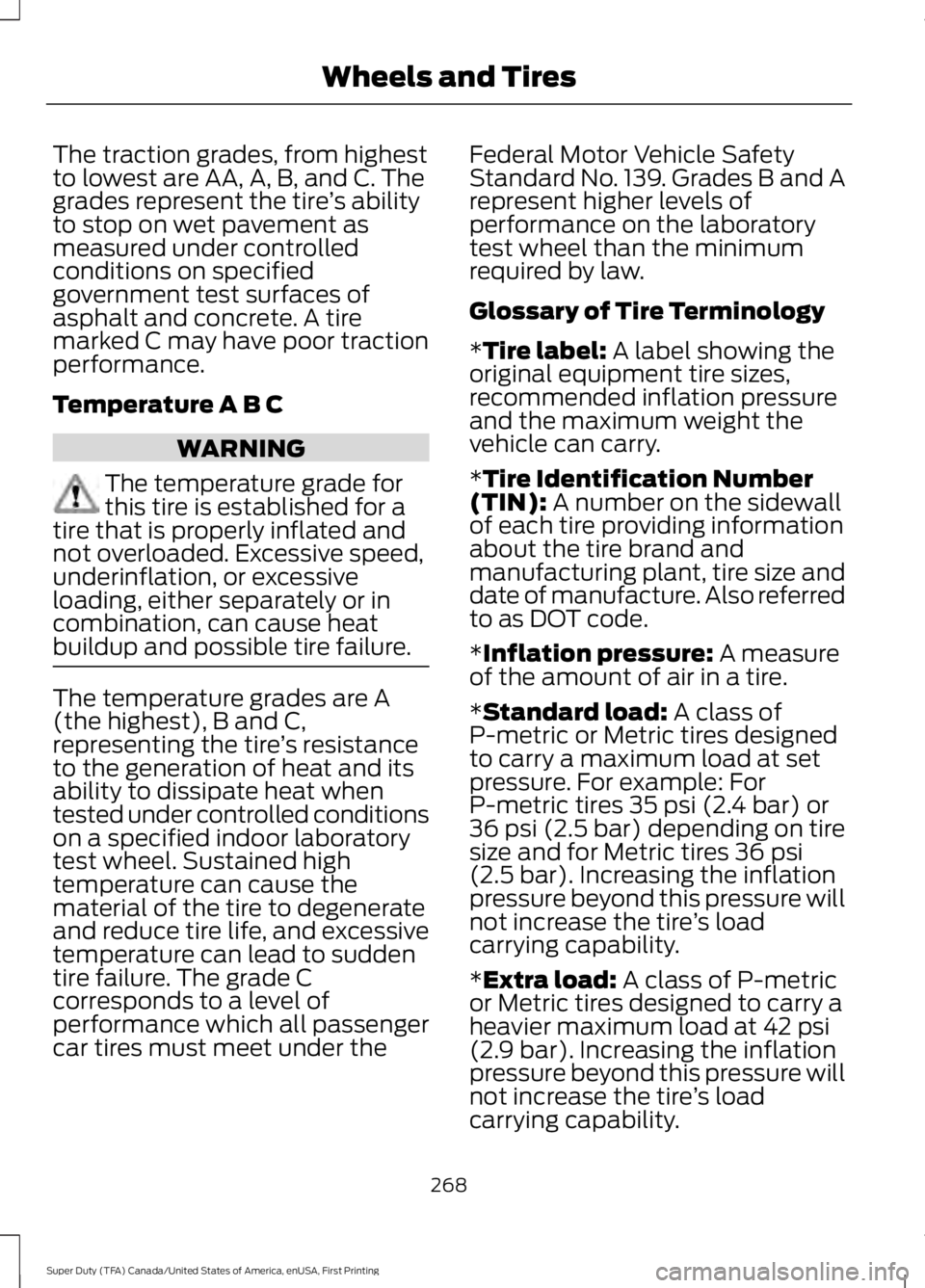
The traction grades, from highestto lowest are AA, A, B, and C. Thegrades represent the tire’s abilityto stop on wet pavement asmeasured under controlledconditions on specifiedgovernment test surfaces ofasphalt and concrete. A tiremarked C may have poor tractionperformance.
Temperature A B C
WARNING
The temperature grade forthis tire is established for atire that is properly inflated andnot overloaded. Excessive speed,underinflation, or excessiveloading, either separately or incombination, can cause heat
buildup and possible tire failure.
The temperature grades are A(the highest), B and C,representing the tire’s resistanceto the generation of heat and itsability to dissipate heat whentested under controlled conditionson a specified indoor laboratorytest wheel. Sustained hightemperature can cause thematerial of the tire to degenerateand reduce tire life, and excessivetemperature can lead to suddentire failure. The grade Ccorresponds to a level ofperformance which all passengercar tires must meet under the
Federal Motor Vehicle SafetyStandard No. 139. Grades B and Arepresent higher levels ofperformance on the laboratorytest wheel than the minimumrequired by law.
Glossary of Tire Terminology
*Tire label: A label showing theoriginal equipment tire sizes,recommended inflation pressureand the maximum weight thevehicle can carry.
*Tire Identification Number(TIN): A number on the sidewallof each tire providing informationabout the tire brand andmanufacturing plant, tire size anddate of manufacture. Also referredto as DOT code.
*Inflation pressure: A measureof the amount of air in a tire.
*Standard load: A class ofP-metric or Metric tires designedto carry a maximum load at setpressure. For example: ForP-metric tires 35 psi (2.4 bar) or36 psi (2.5 bar) depending on tiresize and for Metric tires 36 psi(2.5 bar). Increasing the inflationpressure beyond this pressure willnot increase the tire’s loadcarrying capability.
*Extra load: A class of P-metricor Metric tires designed to carry aheavier maximum load at 42 psi(2.9 bar). Increasing the inflationpressure beyond this pressure willnot increase the tire’s loadcarrying capability.
268
Super Duty (TFA) Canada/United States of America, enUSA, First Printing
Wheels and Tires
Page 274 of 507
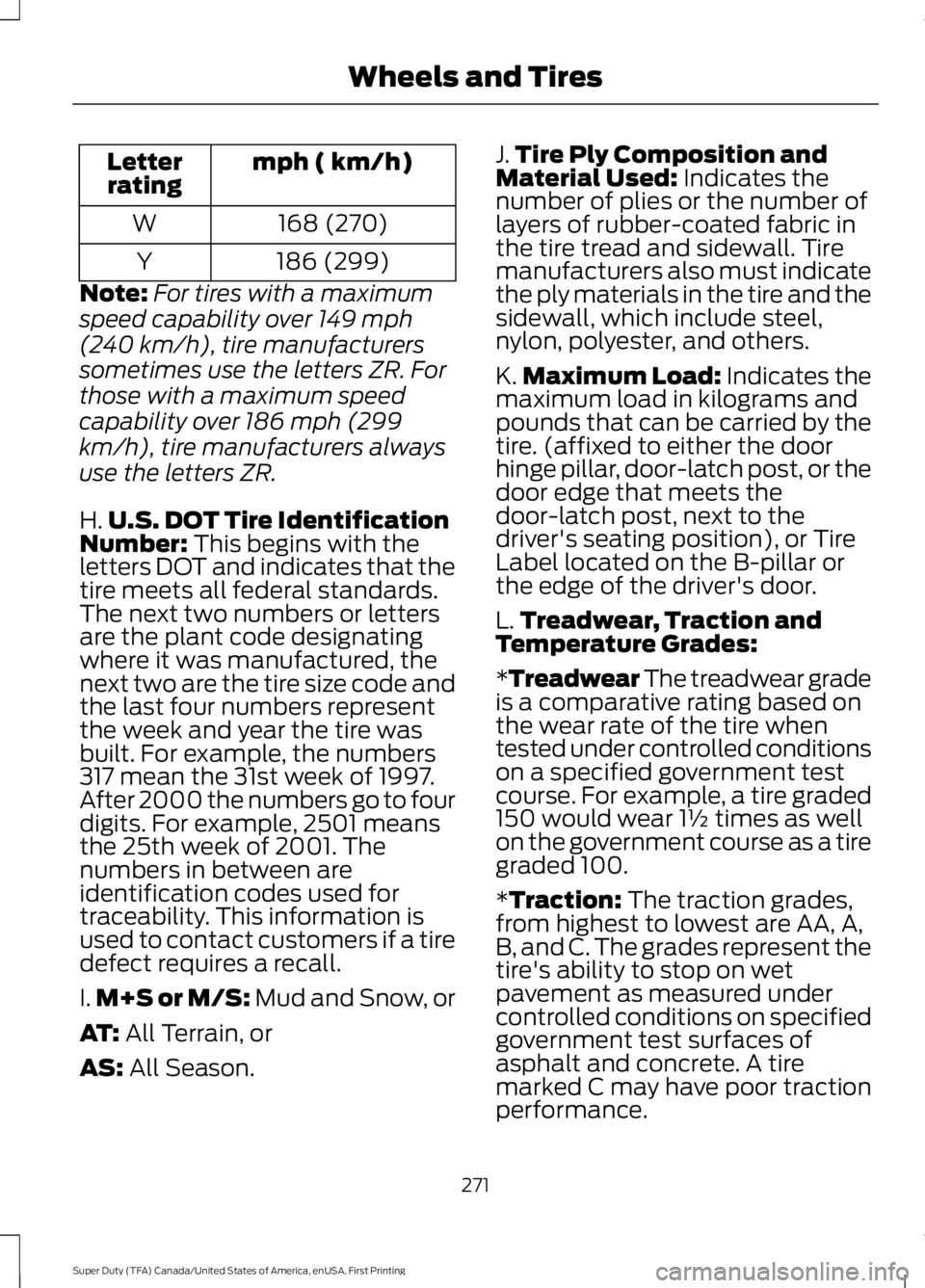
mph ( km/h)Letterrating
168 (270)W
186 (299)Y
Note:For tires with a maximum
speed capability over 149 mph
(240 km/h), tire manufacturers
sometimes use the letters ZR. For
those with a maximum speed
capability over 186 mph (299
km/h), tire manufacturers always
use the letters ZR.
H.U.S. DOT Tire IdentificationNumber: This begins with theletters DOT and indicates that thetire meets all federal standards.The next two numbers or lettersare the plant code designatingwhere it was manufactured, thenext two are the tire size code andthe last four numbers representthe week and year the tire wasbuilt. For example, the numbers317 mean the 31st week of 1997.After 2000 the numbers go to fourdigits. For example, 2501 meansthe 25th week of 2001. Thenumbers in between areidentification codes used fortraceability. This information isused to contact customers if a tiredefect requires a recall.
I.M+S or M/S: Mud and Snow, or
AT: All Terrain, or
AS: All Season.
J.Tire Ply Composition andMaterial Used: Indicates thenumber of plies or the number oflayers of rubber-coated fabric inthe tire tread and sidewall. Tiremanufacturers also must indicatethe ply materials in the tire and thesidewall, which include steel,nylon, polyester, and others.
K.Maximum Load: Indicates themaximum load in kilograms andpounds that can be carried by thetire. (affixed to either the doorhinge pillar, door-latch post, or thedoor edge that meets thedoor-latch post, next to thedriver's seating position), or TireLabel located on the B-pillar orthe edge of the driver's door.
L.Treadwear, Traction andTemperature Grades:
*Treadwear The treadwear gradeis a comparative rating based onthe wear rate of the tire whentested under controlled conditionson a specified government testcourse. For example, a tire graded150 would wear 1½ times as wellon the government course as a tiregraded 100.
*Traction: The traction grades,from highest to lowest are AA, A,B, and C. The grades represent thetire's ability to stop on wetpavement as measured undercontrolled conditions on specifiedgovernment test surfaces ofasphalt and concrete. A tire
marked C may have poor tractionperformance.
271
Super Duty (TFA) Canada/United States of America, enUSA, First Printing
Wheels and Tires
Page 287 of 507
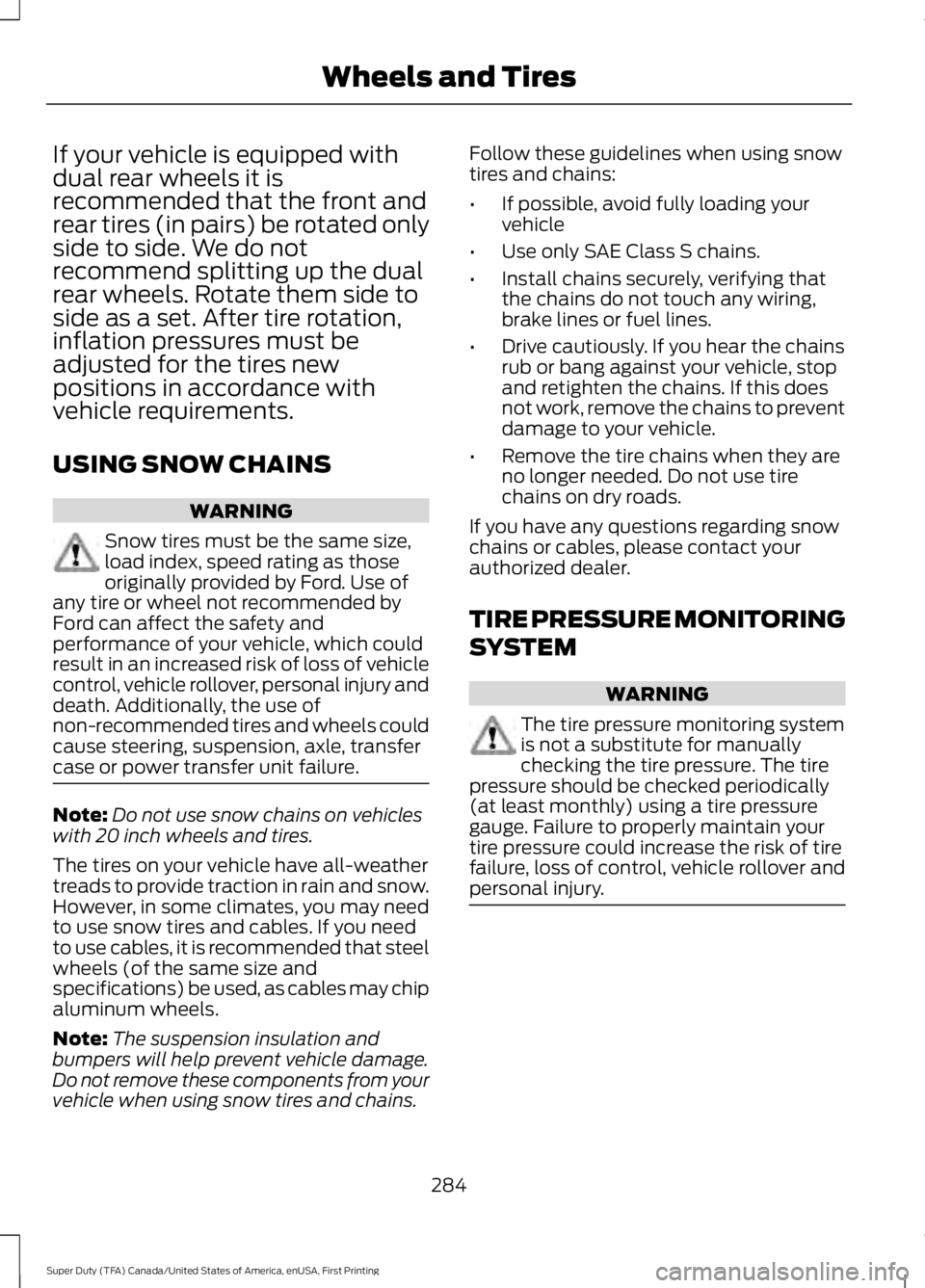
If your vehicle is equipped withdual rear wheels it isrecommended that the front andrear tires (in pairs) be rotated onlyside to side. We do notrecommend splitting up the dualrear wheels. Rotate them side toside as a set. After tire rotation,inflation pressures must beadjusted for the tires newpositions in accordance withvehicle requirements.
USING SNOW CHAINS
WARNING
Snow tires must be the same size,load index, speed rating as thoseoriginally provided by Ford. Use ofany tire or wheel not recommended byFord can affect the safety andperformance of your vehicle, which couldresult in an increased risk of loss of vehiclecontrol, vehicle rollover, personal injury anddeath. Additionally, the use ofnon-recommended tires and wheels couldcause steering, suspension, axle, transfercase or power transfer unit failure.
Note:Do not use snow chains on vehicleswith 20 inch wheels and tires.
The tires on your vehicle have all-weathertreads to provide traction in rain and snow.However, in some climates, you may needto use snow tires and cables. If you needto use cables, it is recommended that steelwheels (of the same size andspecifications) be used, as cables may chipaluminum wheels.
Note:The suspension insulation andbumpers will help prevent vehicle damage.Do not remove these components from yourvehicle when using snow tires and chains.
Follow these guidelines when using snowtires and chains:
•If possible, avoid fully loading yourvehicle
•Use only SAE Class S chains.
•Install chains securely, verifying thatthe chains do not touch any wiring,brake lines or fuel lines.
•Drive cautiously. If you hear the chainsrub or bang against your vehicle, stopand retighten the chains. If this doesnot work, remove the chains to preventdamage to your vehicle.
•Remove the tire chains when they areno longer needed. Do not use tirechains on dry roads.
If you have any questions regarding snowchains or cables, please contact yourauthorized dealer.
TIRE PRESSURE MONITORING
SYSTEM
WARNING
The tire pressure monitoring systemis not a substitute for manuallychecking the tire pressure. The tirepressure should be checked periodically(at least monthly) using a tire pressuregauge. Failure to properly maintain yourtire pressure could increase the risk of tirefailure, loss of control, vehicle rollover andpersonal injury.
284
Super Duty (TFA) Canada/United States of America, enUSA, First Printing
Wheels and Tires
Page 464 of 507
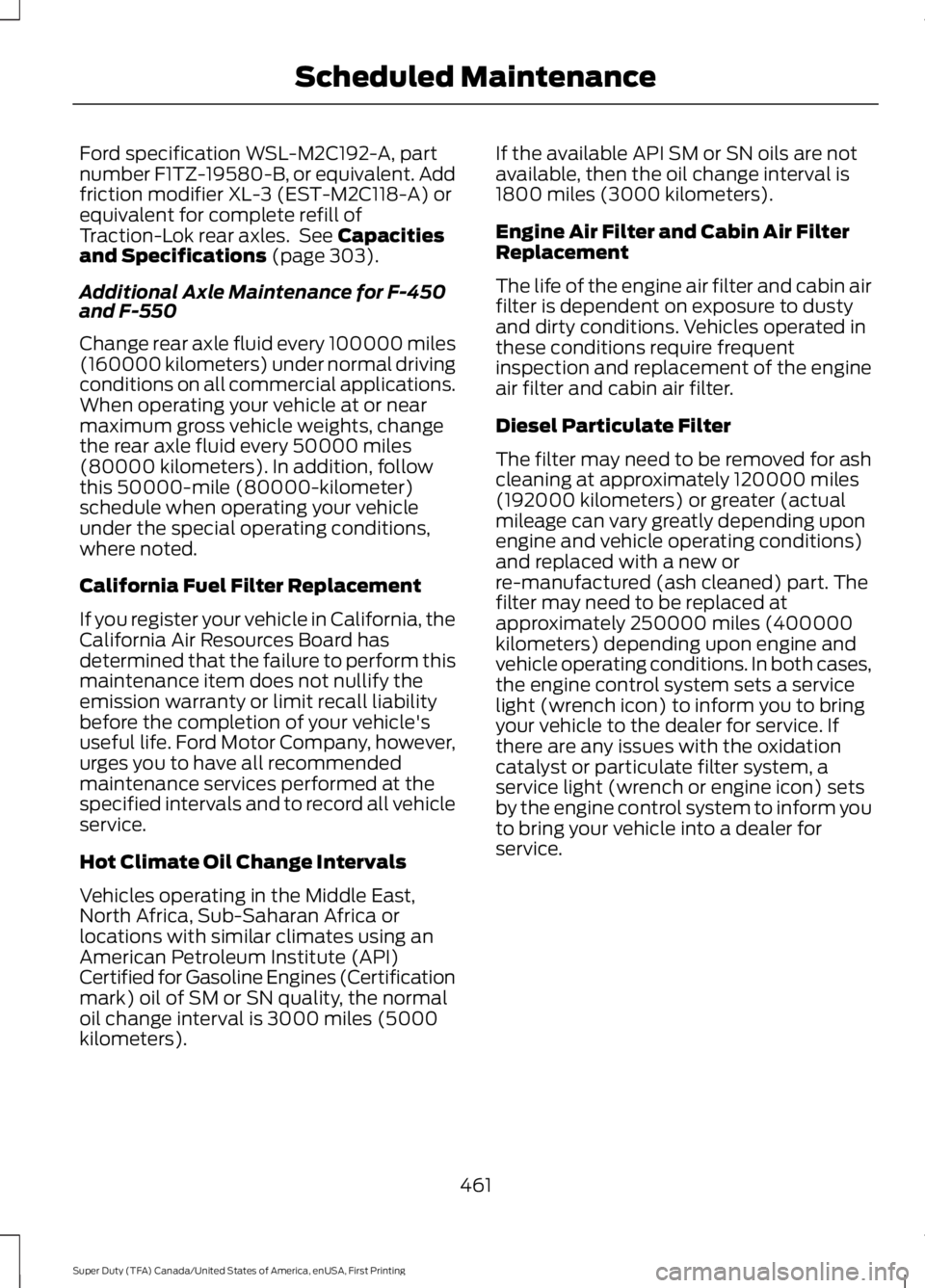
Ford specification WSL-M2C192-A, partnumber F1TZ-19580-B, or equivalent. Addfriction modifier XL-3 (EST-M2C118-A) orequivalent for complete refill ofTraction-Lok rear axles. See Capacitiesand Specifications (page 303).
Additional Axle Maintenance for F-450and F-550
Change rear axle fluid every 100000 miles(160000 kilometers) under normal drivingconditions on all commercial applications.When operating your vehicle at or nearmaximum gross vehicle weights, changethe rear axle fluid every 50000 miles(80000 kilometers). In addition, followthis 50000-mile (80000-kilometer)schedule when operating your vehicleunder the special operating conditions,where noted.
California Fuel Filter Replacement
If you register your vehicle in California, theCalifornia Air Resources Board hasdetermined that the failure to perform thismaintenance item does not nullify theemission warranty or limit recall liabilitybefore the completion of your vehicle'suseful life. Ford Motor Company, however,urges you to have all recommendedmaintenance services performed at thespecified intervals and to record all vehicleservice.
Hot Climate Oil Change Intervals
Vehicles operating in the Middle East,North Africa, Sub-Saharan Africa orlocations with similar climates using anAmerican Petroleum Institute (API)Certified for Gasoline Engines (Certificationmark) oil of SM or SN quality, the normaloil change interval is 3000 miles (5000kilometers).
If the available API SM or SN oils are notavailable, then the oil change interval is1800 miles (3000 kilometers).
Engine Air Filter and Cabin Air FilterReplacement
The life of the engine air filter and cabin airfilter is dependent on exposure to dustyand dirty conditions. Vehicles operated inthese conditions require frequentinspection and replacement of the engineair filter and cabin air filter.
Diesel Particulate Filter
The filter may need to be removed for ashcleaning at approximately 120000 miles(192000 kilometers) or greater (actualmileage can vary greatly depending uponengine and vehicle operating conditions)and replaced with a new orre-manufactured (ash cleaned) part. Thefilter may need to be replaced atapproximately 250000 miles (400000kilometers) depending upon engine andvehicle operating conditions. In both cases,the engine control system sets a servicelight (wrench icon) to inform you to bringyour vehicle to the dealer for service. Ifthere are any issues with the oxidationcatalyst or particulate filter system, aservice light (wrench or engine icon) setsby the engine control system to inform youto bring your vehicle into a dealer forservice.
461
Super Duty (TFA) Canada/United States of America, enUSA, First Printing
Scheduled Maintenance
Page 480 of 507
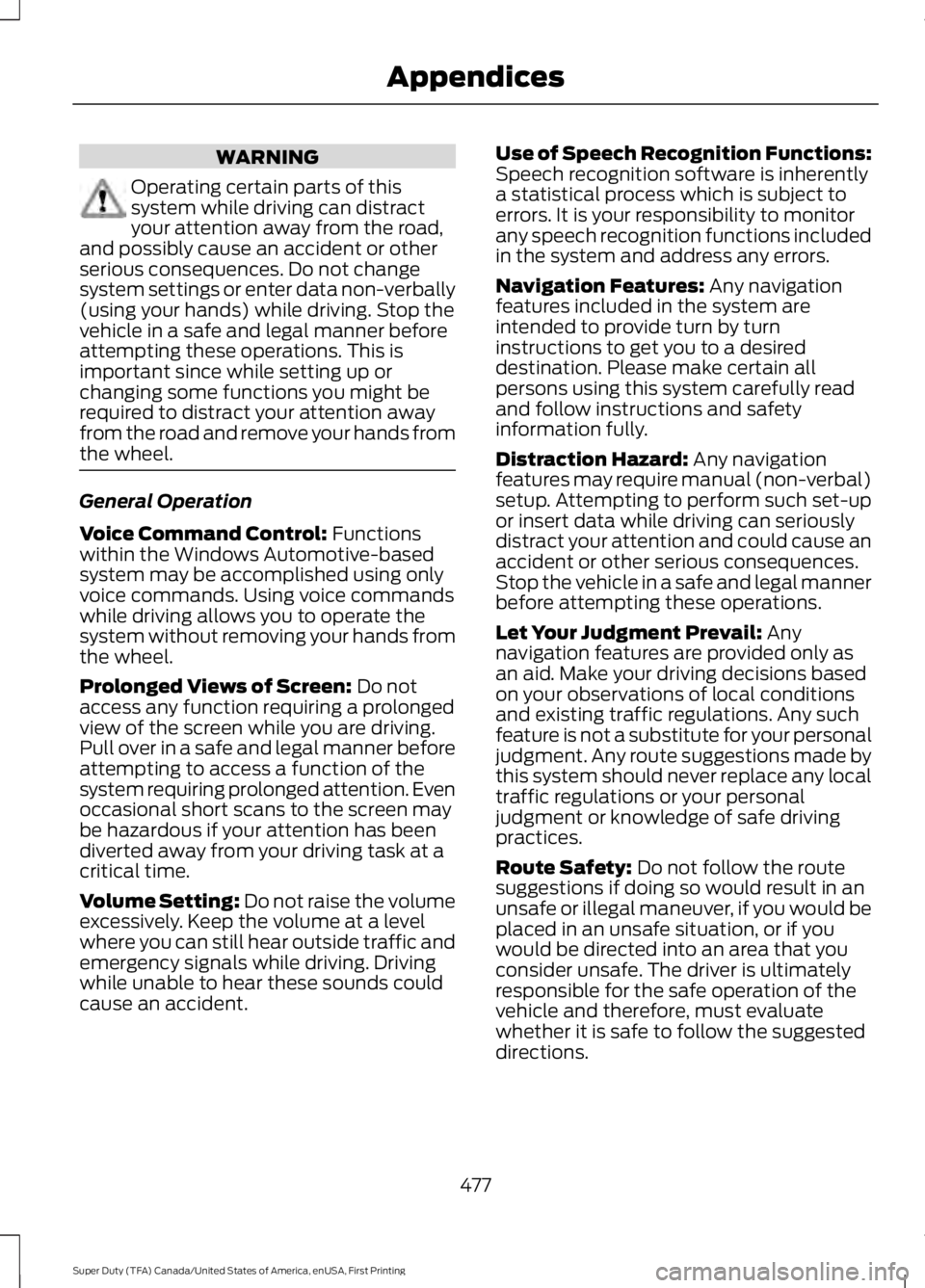
WARNING
Operating certain parts of thissystem while driving can distractyour attention away from the road,and possibly cause an accident or otherserious consequences. Do not changesystem settings or enter data non-verbally(using your hands) while driving. Stop thevehicle in a safe and legal manner beforeattempting these operations. This isimportant since while setting up orchanging some functions you might berequired to distract your attention awayfrom the road and remove your hands fromthe wheel.
General Operation
Voice Command Control: Functionswithin the Windows Automotive-basedsystem may be accomplished using onlyvoice commands. Using voice commandswhile driving allows you to operate thesystem without removing your hands fromthe wheel.
Prolonged Views of Screen: Do notaccess any function requiring a prolongedview of the screen while you are driving.Pull over in a safe and legal manner beforeattempting to access a function of thesystem requiring prolonged attention. Evenoccasional short scans to the screen maybe hazardous if your attention has beendiverted away from your driving task at acritical time.
Volume Setting: Do not raise the volumeexcessively. Keep the volume at a levelwhere you can still hear outside traffic andemergency signals while driving. Drivingwhile unable to hear these sounds couldcause an accident.
Use of Speech Recognition Functions:Speech recognition software is inherentlya statistical process which is subject toerrors. It is your responsibility to monitorany speech recognition functions includedin the system and address any errors.
Navigation Features: Any navigationfeatures included in the system areintended to provide turn by turninstructions to get you to a desireddestination. Please make certain allpersons using this system carefully readand follow instructions and safetyinformation fully.
Distraction Hazard: Any navigationfeatures may require manual (non-verbal)setup. Attempting to perform such set-upor insert data while driving can seriouslydistract your attention and could cause anaccident or other serious consequences.Stop the vehicle in a safe and legal mannerbefore attempting these operations.
Let Your Judgment Prevail: Anynavigation features are provided only asan aid. Make your driving decisions basedon your observations of local conditionsand existing traffic regulations. Any suchfeature is not a substitute for your personaljudgment. Any route suggestions made bythis system should never replace any localtraffic regulations or your personaljudgment or knowledge of safe drivingpractices.
Route Safety: Do not follow the routesuggestions if doing so would result in anunsafe or illegal maneuver, if you would beplaced in an unsafe situation, or if youwould be directed into an area that youconsider unsafe. The driver is ultimatelyresponsible for the safe operation of thevehicle and therefore, must evaluatewhether it is safe to follow the suggesteddirections.
477
Super Duty (TFA) Canada/United States of America, enUSA, First Printing
Appendices
Page 505 of 507

Snowplowing................................................209Engine temperature while plowing..............210Installing the Snowplow.................................209Operating the Vehicle with the SnowplowAttached...........................................................210Snowplowing with your Airbag EquippedVehicle...............................................................210Transmission operation whileplowing...............................................................211Special Notices................................................12New Vehicle Limited Warranty.........................12On-board Diagnostics (OBD-II).......................12Special Instructions..............................................12Using your Vehicle as an Ambulance.............12Using your Vehicle as a Stationary PowerSource...................................................................13Using your Vehicle With a Snowplow............12Special Operating Conditions ScheduledMaintenance...............................................4576.2L and 6.8L Gasoline Engines...................4576.7L Diesel Engine.............................................460Exceptions...........................................................460Speed ControlSee: Cruise Control............................................183Stability Control.............................................174Principle of Operation.......................................174Starter SwitchSee: Ignition Switch...........................................140Starting a Gasoline Engine.........................141Cold Weather Starting (Flexible FuelVehicles Only)..................................................141Failure to Start......................................................141Guarding Against Exhaust Fumes................142Important Ventilating Information...............142Stopping the Engine When Your Vehicle isMoving.................................................................141Stopping the Engine When Your Vehicle isStationary..........................................................141Starting and Stopping the Engine.........140General Information..........................................140Steering............................................................184Steering Wheel...............................................66Storage Compartments.............................139SunroofSee: Moonroof......................................................80Sun Visors.........................................................80Illuminated Vanity Mirror..................................80Slide-on-rod..........................................................80
Supplementary Restraints System..........37Principle of Operation.........................................37Symbols Glossary.............................................7SYNC™ Applications andServices........................................................346911 Assist...............................................................346SYNC Services: Traffic, Directions &Information (TDI) (If Equipped, UnitedStates Only)...................................................350Vehicle Health Report (If Equipped, UnitedStates Only)...................................................348SYNC™ AppLink™.....................................354SYNC Mobile Apps............................................354SYNC™............................................................329General Information.........................................329SYNC™ Troubleshooting.........................365
T
Tailgate Lock...................................................60Tailgate Step.....................................................61Closing the step.....................................................61Opening the step...................................................61Tailgate..............................................................60Technical SpecificationsSee: Capacities and Specifications............303Terrain Response...........................................177Principle of Operation........................................177The Better Business Bureau (BBB) AutoLine Program (U.S. Only)........................219Tire Care..........................................................267Glossary of Tire Terminology........................268Information About Uniform Tire QualityGrading..............................................................267Information Contained on the TireSidewall...........................................................269Temperature A B C............................................268Traction AA A B C...............................................267Treadwear.............................................................267Tire Pressure Monitoring System..........284Changing Tires With a Tire PressureMonitoring System.......................................286Understanding Your Tire PressureMonitoring System ......................................286TiresSee: Wheels and Tires.....................................264Towing a Trailer.............................................192Load Placement..................................................192
502
Super Duty (TFA) Canada/United States of America, enUSA, First Printing
Index
Page 506 of 507
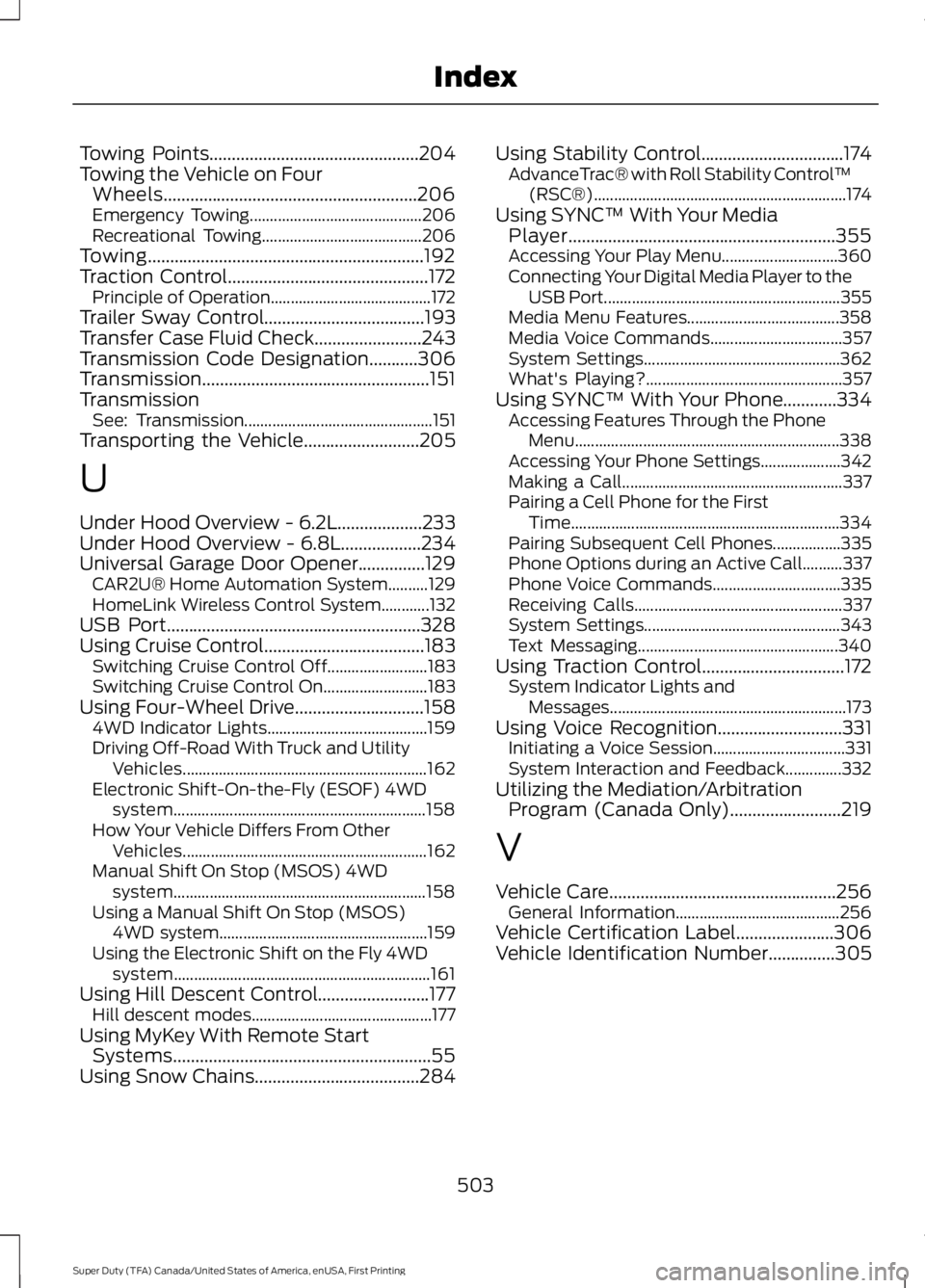
Towing Points...............................................204Towing the Vehicle on FourWheels.........................................................206Emergency Towing...........................................206Recreational Towing........................................206Towing..............................................................192Traction Control.............................................172Principle of Operation........................................172Trailer Sway Control....................................193Transfer Case Fluid Check........................243Transmission Code Designation...........306Transmission...................................................151TransmissionSee: Transmission...............................................151Transporting the Vehicle..........................205
U
Under Hood Overview - 6.2L...................233Under Hood Overview - 6.8L..................234Universal Garage Door Opener...............129CAR2U® Home Automation System..........129HomeLink Wireless Control System............132USB Port.........................................................328Using Cruise Control....................................183Switching Cruise Control Off.........................183Switching Cruise Control On..........................183Using Four-Wheel Drive.............................1584WD Indicator Lights........................................159Driving Off-Road With Truck and UtilityVehicles.............................................................162Electronic Shift-On-the-Fly (ESOF) 4WDsystem...............................................................158How Your Vehicle Differs From OtherVehicles.............................................................162Manual Shift On Stop (MSOS) 4WDsystem...............................................................158Using a Manual Shift On Stop (MSOS)4WD system....................................................159Using the Electronic Shift on the Fly 4WDsystem................................................................161Using Hill Descent Control.........................177Hill descent modes.............................................177Using MyKey With Remote StartSystems..........................................................55Using Snow Chains.....................................284
Using Stability Control................................174AdvanceTrac® with Roll Stability Control™(RSC®)...............................................................174Using SYNC™ With Your MediaPlayer............................................................355Accessing Your Play Menu.............................360Connecting Your Digital Media Player to theUSB Port...........................................................355Media Menu Features......................................358Media Voice Commands.................................357System Settings.................................................362What's Playing?.................................................357Using SYNC™ With Your Phone............334Accessing Features Through the PhoneMenu..................................................................338Accessing Your Phone Settings....................342Making a Call.......................................................337Pairing a Cell Phone for the FirstTime...................................................................334Pairing Subsequent Cell Phones.................335Phone Options during an Active Call..........337Phone Voice Commands................................335Receiving Calls....................................................337System Settings.................................................343Text Messaging..................................................340Using Traction Control................................172System Indicator Lights andMessages...........................................................173Using Voice Recognition............................331Initiating a Voice Session.................................331System Interaction and Feedback..............332Utilizing the Mediation/ArbitrationProgram (Canada Only).........................219
V
Vehicle Care...................................................256General Information.........................................256Vehicle Certification Label......................306Vehicle Identification Number...............305
503
Super Duty (TFA) Canada/United States of America, enUSA, First Printing
Index